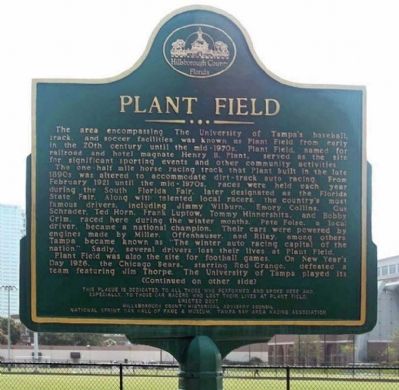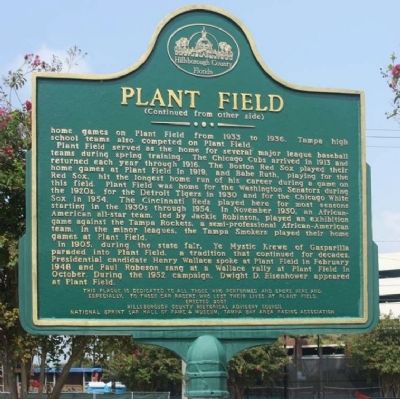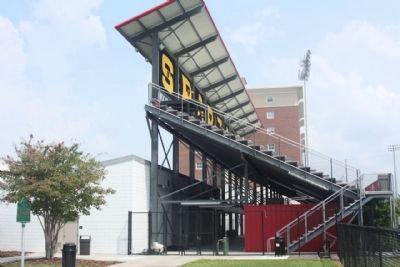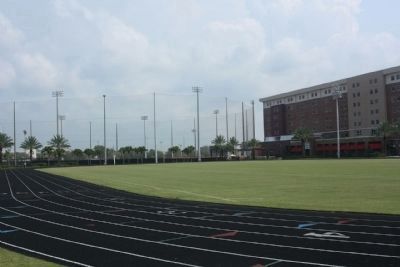Tampa in Hillsborough County, Florida — The American South (South Atlantic)
Plant Field
The area encompassing The University of Tampa's baseball, track, and soccer facilities was known as Plant Field from early in the 20th century until the mid - 1970s. Plant Field, named for railroad and hotel magnate Henry B. Plant, served as the site for significant sporting events and other community activities.
The one-half mile horse racing track that Plant built in the late 1890s was altered to accommodate dirt-track auto racing. From February 1921 until the mid-1970s, races were held each year during the South Florida Fair, later designated as the Florida State Fair. Along with talented local racers, the country's most famous drivers, including Jimmy Wilburn, Emory Collins, Gus Schrader, Ted Horn, Frank Luptow, Tommy Hinnershitz, and Bobby Grim, raced here during the winter months. Pete Folse, a local driver, became a national champion. Their cars were powered by engines made by Miller, Offenhause, and Riley, among others. Tampa became known as "The winter auto racing capital of the nation." Sadly several drivers lost their lives at Plant Field.
Plant Field was also the site for football games. On New Year's Day 1926, the Chicago Bears, starring Red Grange, defeated a team featuring Jim Thorpe. The University of Tampa played its home games on Plant Field from 1933 to 1936. Tampa high school teams also competed on Plant Field.
Plant Field served as the home for several major league baseball teams during spring training. The Chicago Cubs arrived in 1913 and returned each year through 1916. The Boston Red Sox played their home games at Plant Field in 1919, and Babe Ruth, playing for the Red Sox, hit the longest home run of his career during a game on this field. Plant Field was home for the Washington Senators during the 1920s, for the Detroit Tigers in 1930 and for the Chicago White Sox in 1954. The Cincinnati Reds played here the most seasons starting in the 1930s through 1954. In November 1950, an African- American all-star team, led by Jackie Robinson, played an exhibition game against the Tampa Rockets, a semi-professional African-American team. In the minor leagues, the Tampa Smokers played their home games at Plant Field.
In 1905, during the state fair, Ye Mystic Krewe of Gasparilla paraded into Plant Field, a tradition that continued for decades. Presidential candidate Henry Wallace spoke at Plant Field in February 1948 and Paul Robeson sang at a Wallace rally at Plant Field in October. During the 1952 campaign, Dwight D. Eisenhower appeared at Plant Field.
This Plaque is dedicated to all those who performed and spoke here and, especially, to those car racers who lost their lives at Plant Field.
Erected 2007 by Hillsborough County Historical Advisory Council, National Sprint Car Hall of Fame and Museum, Tampa Bay Area Racing Association.
Topics and series. This historical marker is listed in this topic list: Notable Places. In addition, it is included in the Former U.S. Presidents: #34 Dwight D. Eisenhower series list. A significant historical month for this entry is February 1921.
Location. 27° 56.859′ N, 82° 28.088′ W. Marker is in Tampa, Florida, in Hillsborough County. Marker is on North Blvd. near W North B Street, on the left when traveling south. Touch for map. Marker is in this post office area: Tampa FL 33606, United States of America. Touch for directions.
Other nearby markers. At least 8 other markers are within walking distance of this marker. Babe's Longest Homer (approx. 0.2 miles away); Old Schoolhouse (approx. 0.2 miles away); Tampa Bay Hotel, 1891 (approx. ¼ mile away); United Spanish War Veterans (approx. ¼ mile away); a different marker also named Tampa Bay Hotel (approx. 0.3 miles away); De Soto (approx. 0.3 miles away); Fort Brooke Battery (approx. 0.3 miles away); The Rough Riders Procure a Coal Train (approx. 0.3 miles away). Touch for a list and map of all markers in Tampa.
Regarding Plant Field. Plant Field was the first large spectator sports facility in the area. It was built in 1889 by Henry B. Plant across the Hillsborough River from Tampa as part of his Tampa Bay Hotel resort. As the only facility of its kind in Central Florida, Plant Field hosted a wide variety of events, including auto and horse racing; pro, college, and high school football; and large political events. It was also the long-time location of the Florida State Fair, and the route of the Gasparilla parade would end on Plant Field's track while the fair was in session. Plant Field was also the first home of the minor league Tampa Smokers, the area's first professional baseball team, and was one of the first spring training sites in Florida, hosting several different teams over the decades. During one of the earliest ballgames in April 1919, Babe Ruth reportedly hit his longest home run - a 587 foot blast that is memorialized with a historical marker at the approximate location were it landed at the current site of the University of Tampa's school of business.
The University of Tampa took over Plant Field in the early 1970s and renamed it Peppin-Rood Stadium after university benefactors. Since then, the school has built new facilities on its huge footprint, including a soccer field (Peppin Stadium), softball and baseball fields, dormitories, and other academic and athletic facilities. While a portion of the old playing surface is still in use as part of newer venues, the last remaining portions
of Plant Field's old grandstand was torn down in 2002. (Wikipedia)
Also see . . . Plant Field, from Wikipedia. Plant Field was the first major athletic stadium in Tampa, Florida. It was originally built by Henry B. Plant, owner of the Tampa Bay Hotel, in 1899 as an area to provide various activities for his guests. (Submitted on August 28, 2011, by Mike Stroud of Bluffton, South Carolina.)
Credits. This page was last revised on July 29, 2020. It was originally submitted on August 28, 2011, by Mike Stroud of Bluffton, South Carolina. This page has been viewed 2,110 times since then and 53 times this year. Photos: 1, 2, 3, 4. submitted on August 28, 2011, by Mike Stroud of Bluffton, South Carolina.



